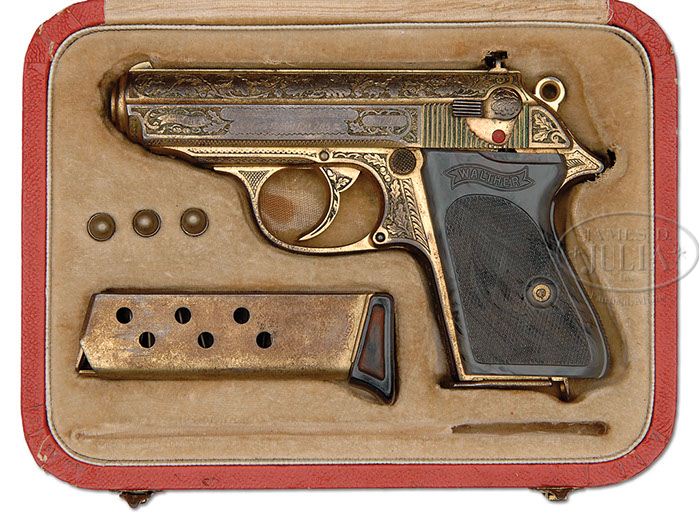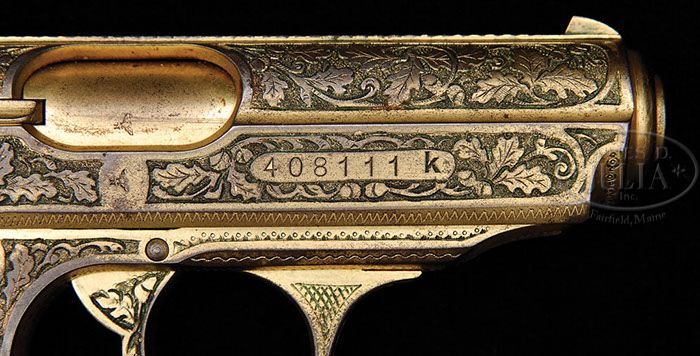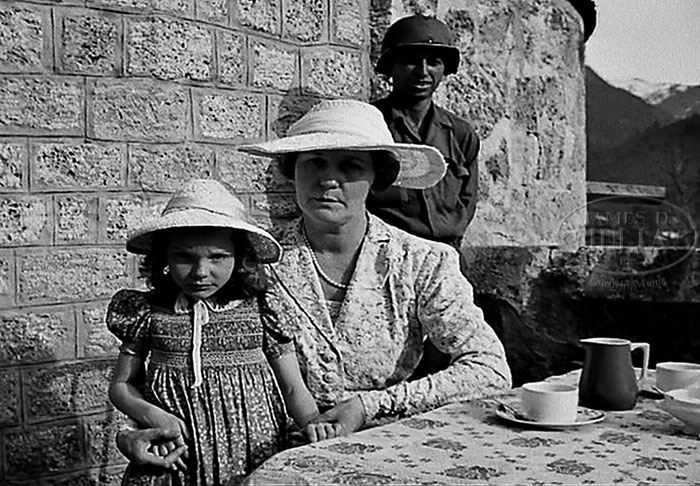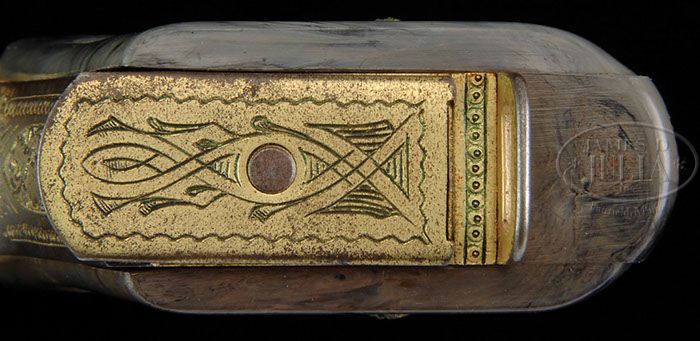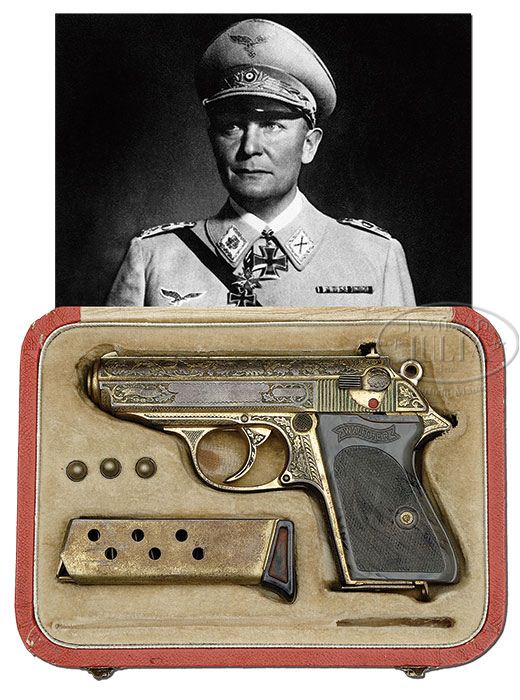| Image | Lot | Price | Description |
|
2478
|
$40,250.00
|
Revised: 9/17/2012
Correction: Firearm is modern. RARE HISTORIC AND IMPORTANT SURRENDERED WALTHER PPK RECEIVED FROM REICH MARSHALL HERMANN GOERING AT THE TIME OF HIS CAPTURE BY JEROME SHAPIRO OF THE 142ND INTELLIGENCE AND RECONNAISSANCE PLATOON. SN 408111k. Cal 32. This cased gold washed engraved 32 cal. Walther PPK together with spare clip and three rounds of ammunition were surrendered by Herman Goering at the time of his capture in early May of 1945, at the conclusion of WWII. Details of the circumstances are enthralling, and are outlined in a declaration made by a Major Ronald W. Lane, Major U.S. Air force retired (a photocopy of which is included in this lot). In the statement Lane indicates that he was a flying officer in the U.S. Air force for 22 years. In 1961 he was stationed at Dover Air force base, and all during that time was an avid collector or Military memorabilia. In 1961 he was stationed at Dover Air Force base in Delaware and it was here that he met 1st Lt. Jerome Shapiro. He indicates that he knew Shapiro had been the officer who captured Goering at the conclusion of WWII and while in Dover struck up a relationship with Shapiro which evolved into a long term relationship. In 1968 as he was preparing to leave and verbally expressed to Lt. Shapiro that should Shapiro ever wish to sell the Goering surrender pistol he would very much like to have it for his collection. It was at that time Shapiro needing money for his daughter who was going to college made a deal and shook hands. Major Lane left a $1000.00 down payment and agreed to future payments over a period of time. Shortly afterwards Lt. Shapiro unfortunately passed away, but his wife fortunately kept the bargain and after final payments were made turned over the pistol (a photocopy of which is included), and a document relating to this pistol provided by Mrs. Shapiro relating to this exact pistol. Major Lane also acquired a number of other things at the same time with the pistol, some of which were Jerome Shapiro’s including his bronze star (not included in this lot) together with some small artifacts, an ivory handled dagger and some other artifacts supposedly acquired from Goering (none of which is included in this lot). The story involving the capture of Goering is unquestionably enthralling. Lane goes on to state that after he acquired the items, he personally visited with 1st Lt. Gordon Sill who was formally of the 636 Tank Destroyer battalion of the 36th Infantry division and also later visited with Sgt. Lester Leggett who served in a platoon of the 636th. Both of these army men were present when Lt. Jerome Shapiro brought in Reich Marshall Hermann Goering. The information that Maj. Lane obtained from Lt. Shapiro and these other two officers in part are the source of information for the following story. He goes on to state that: “early May of 1945, General Robert L. Stack, Asst. Div. Commander of the 36th Infantry Division was contacted by a German officer and was advised the Reich Marshall Hermann Goering wished to surrender. Gen. Stack contacted first Lt. Gordon Sill of the 636th Tank Destroyer Battalion and requested that any available unit or units that could possibly be made available should immediately assist Stack in capturing a “high ranking German officer”. A Platoon Sgt. Lester Lugit of the 636th and 1st Lt. Jerome Shapiro attached to the 142nd Intelligence and Reconnaissance patrol were some of the men provided for this purpose. When Gen. Stack and the rest of the staff arrived at the castle where they assumed the Goering to be, Goering was not present. Units were then sent out in different directions to locate Goering. Lt. Shapiro and the men under his command discovered Goering on a congested road overrun with weaponry and soldiers. Goering and his entire entourage were stuck in traffic and within a mass of people. He was in his bulletproof Mercedes limousine with his wife and daughter. There were approximately 11 other vehicles together with several of Goering’s officers and a large number of suitcases. Lt. Shapiro approached Goering with his Colt .45 drawn which was unnecessary as Goering was anxious to surrender. Shapiro requested Goering’s sidearm. Goering asked to empty the Smith & Weston pistol and keep it with him. The purpose of which was to personally surrender to Gen. Eisenhower. Goering offered not only to unload the Smith & Wesson pistol but to give Lt. Shapiro the gold plated Walther PPK as a symbol of his surrender which Shapiro accepted. He then accompanied Goering back to the castle where Gen. Stack and his staff awaited. Shapiro told me that the first night he was one of the guards to watch Goering. Shapiro spoke four different languages, German being one, and he could easily converse with Goering. Shapiro indicated that he developed a sort of rapport with him and during the Nuremburg Trials; Goering had specifically requested that Lt. Shapiro be one of his guards. That was not totally to Shapiro’s liking because he wanted to return home. The Nuremburg Trials resulted in him staying longer than he had anticipated. During the time, Shapiro guarded Goering on many occasions and either as a personal favor or as a trade, Goering gave Lt. Shapiro various items of his personal possessions; including a typewriter, stickpin, parts of his army uniform, opera glasses, ivory handled dagger/sword, and a wristwatch that was engraved and given to Goering by Adolf Hitler, also a watch fob. These items were all part of Shapiro’s collection when I met him in the early 1960’s.” Maj. Lane goes on to state: “that sometime after the war Gen. Stack forwarded a letter to Lt. Shapiro that had been sent to Stack by the Boy Scouts of America. The Boy Scouts were requesting the signature of the man who had captured Goering. In forwarding the Boy Scout letter, Gen. Stack included his own cover letter requesting Lt. Shapiro to respond to the Boys Scouts and to provide a signature since it was Shapiro that had captured Goering and not Stack: who is in some cases is mistakenly given credit.” Lane goes on to state in his declaration that his assignment of finding Goering was a particularly scary one. He and his men in a single jeep had to drive some 80 miles behind enemy lines and despite the fact that this was the ending days of the war, SS troops were everywhere. It was without question an exceedingly dangerous mission. In addition, Shapiro being of Jewish decent behind enemy lines in the country where responsible for one of the greatest holocaust in history added another dimension to concern. At this point in time, Hitler had already committed suicide but before doing so reportedly he had a falling out with Goering who suggested he should be put in charge. Reportedly Hitler was enraged at this and directed the SS to kill Goering. It does explain one very strong reason why Goering would want to surrender immediately, but whether it is true or not the fact that the Russian troops were advancing and soon would have Goering within their possession, he most definitely did not want to befall that fate. He well knew what might become of him and his family. He figured his odds were better with the Americans and thus wanted to surrender. We were told that Eisenhower staunchly refused to receive Goering or accept or Smith & Wesson pistol but we have also been told that Goering’s Smith & Wesson pearl handled revolver eventually did find its way into the West Point Museum. Shapiro received the Bronze star for the courageous actions of going behind enemy lines during this very dangerous period to find Goering. June of 2005, long after Shapiro’s death, the Wiesenthal Center presented a Medal of Valor for individual acts of heroism, one of which they presented posthumously to Lt. Jerome Shapiro. It was received by the last surviving member of his platoon, Alfred Frye. An image of Shapiro guarding Goering and his family is available on the internet, stock footage of U.S. Soldiers guarding Mrs. Emmy Goering and her daughter, Edda. In the video, Lt. Jerome Shapiro 36th Division Guard is seen. This can be accessed at www.criticalpast.com/video/65675046982_Emmy-Goering_daughter-Edda_Lieutenant-Jerome-Shapiro_36th-Division-guards Sometime during the 1960s, one of the television networks featured a program entitled the “20th Century”. In it Walter Cronkite was the spokesperson and one such session was an excerpt of Hermann Goering capture by Lt. Jerome Shapiro. Shapiro understandably was extremely proud of what he accomplished and after the war on numerous occasions he lectured about his involvement in the war and specifically the capture of Goering. On these occasions, he always brought the pistols with him on display and over the years literally thousands of people handled this historic gun. (Please note: In October 2001, we sold this exact pistol together with numerous other artifacts that were consigned by Maj. Lane. The lot was sold as a package and an agent representing the buyer attended the auction and purchased the entire package. Most recently we were contacted by a law firm on the West Coast and asked if we would be interested in selling the pistol again. This lot however does not include the various things described and outlined in our package offered in October of 2001. The only thing offered in this lot is Goering PPK Walther cased pistol with spare clip and cartridges together with photocopies of some of our original documentation and copies of other information that we acquired from research. CONDITION: The Walther is possibly unfired but has been handled excessively, wearing away much of the gold with 30 -35% remaining. The worn areas have a natural old dark brown patina. The gun has a bright shiny bore. The red leather case has numerous chips and dings and is missing some small spots of leather. The spare magazine retains perhaps 65-75% of the original gold wash and still retains the 3 cartridges. The interior of the case is soiled and shows appropriate wear for the condition of the gun. This is a truly historic item and surrender guns of officers of such great notoriety rarely ever make it into public hands but usually go directly to museums and thus this represents an extraordinarily rare opportunity to acquire a truly important historical surrender gun. 4-46319 JDJ55 (30,000-90,000)
Auction: Firearms - Fall 2012 Please Note: All prices include the hammer price plus the buyer’s premium, which is paid by the buyer as part of the purchase price. The prices noted here after the auction are considered unofficial and do not become official until after the 46th day. |
